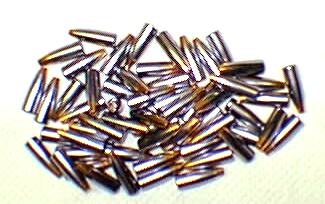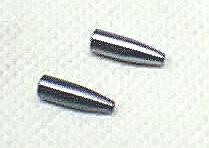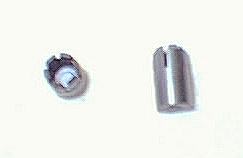Treating Bullets with Molybdenum Disulfide ( MoS2 )
The purpose of this page is to introduce the procedures for 'moly' coating bullets to those of you who have no experience with these processes, and to possibly pass on a few 'tips' and 'lessons learned' to those who are familiar with moly coating bullets. I say 'processes' because there are a few methods available and in wide use.

Moly Spray
'Ms Moly' : Marksman, Inc. / Moly Aerosol : Kano Labs
This method of MoS2 application uses 'moly' in an aerosol can. For about $37, you get (2) 11 oz. cans of 'Ms Moly', which they claim will coat over 3000+ bullets, and guides for setting up your bullets. I've heard that the moly spray from Kano Labs is much less expensive. I have learned (from Marksman and others) that heating the bullets with a blow dryer or heat gun both before AND after application gives better results. Be careful not to knock the bullets over with the wind blast - it can be very frustrating trying to set them standing back up again.
Pros:
- Does NOT 'clog' hollowpoint cavities
- GREAT for treating gun barrels
- No other equipment required (but a hair dryer or heat gun does help)
Cons:
- Application is somewhat wasteful - a lot of the moly ends up NOT on the bullets
- Horrible fumes - need really good ventilation when using this product
- More expensive than the powder for treating bullets
- Messy overspray
Lessons Learned
- Use a heat source to heat the bullets before and after sparaying.
- Use adequate VENTILATION!
- If you do this outside, set up shields so the wind doesn't blow the bullets over.
Midway Powder
This method of MoS2 application uses powdered 'moly'. For about $20, you get a jar with an 8 oz. baggie of 'Moly Ultra-Coat' powder. The procedure is to add the powder to untreated corncob media and a handful of BBs. Tumble this for about 10 minutes to 'treat the media'. Add the powder a little at a time until the media is an even, pewter color. I have found that if you're treating hollowpoints, you can tumble the bullets with BBs only, and the results are also very good. In fact, now I mostly tumble with BBs only. However, if you use too much moly, they won't come out as 'clean' (the moly tends to clump a little on the bullets, but comes right off if lightly rubbed in a paper towel) as when you use treated media and BBs.
Most people clean their bullets by either tumbling them in untreated media or spraying them with either alcohol or brake cleaner. I don't clean new bullets, and have had very good results. However, I DO clean (old) tarnished bullets before I moly treat them. After the bullets are clean, add them to your treated media (or BBs) and tumble them for 1-2 hours. I have found that, like tumbling brass, the more you fill the container with media, the better your results. When using 'BBs only', the amount I fill the container has not mattered. I've coated close to 3000 bullets with Midway's powder so far, and haven't even made a dent in the bag. Get an old bucket and colander to separate your bullets from the media and/or BBs.
Pros:
- Inexpensive
- Minimal effort
- Little to no waste of material
Cons:
- A tumbler is required
- Messy to separate out the treated bullets
- Tends to be 'dusty' - gets in the air
- Media clogs hollowpoint cavities - use 'BBs only' with hollowpoints
Lessons Learned
- I tried taping the hollowpoints closed with a little masking tape to keep the hollowpoint cavities from getting clogged. The work involved was not worth it. It took me longer to apply and remove the tape (it DID stay on in the tumbler) per bullet than it took me to clean out the debris with a dental pick (on another lot of bullets). Also, about 1/3 of the bullets tumbled in the treated media required no 'unclogging' at all.
- Hollowpoint cavities that are about 0.11" in diameter are fairly easy to clean out with a dental pick. I have found that smaller cavities (~ 0.07" in diameter) are definitely just not worth the bother. In fact, you're better off just tumbling all hollowpoints in BBs with moly - forget the moly-treated corncob.
- I have no evidence of how much (IF AT ALL) media clogging a hollowpoint cavity affects bullet accuracy or terminal performance on game.
For more information, 'Moly Coating' from ...
Gallery

- These are the 'taped' bullets prior to tumbling. They are Speer .277" 100 grain HPs. I taped the tips to keep media out. It worked very well, but it just wasn't worth the effort.

- These are the 'taped' bullets after tumbling in the moly powder with the tape removed. The tape stayed on, which surprised me (I thought it might rub off). The tape kept the media OUT of the hollowpoint cavities, too. They really look cool, but were not worth the bother.

- These are bullets in a jar of treated media and BBs. I used a small peanut butter jar, which is holding up very well. This jar goes into the empty tumbler, with a rag to hold down the 'clatter', for 1-2 hours.

- TOP : Midway moly treated Sierra 55 grain .224 HPBT Match
BOTTOM : Ms Moly moly treated Sierra 55 grain .224 HPBT Match
The Midway powder treated bullets (silver) have a high luster. The Ms Moly (pewter colored) treated bullets have no luster. This is purely cosmetic, and should have no effect on performance.

- These are .224" --> .308" moly treated sabots. I don't know which method I prefer for sabots. The spray is wasteful, but easy - while the powder method coats the outside AND inside (may release the bullet 'nicer') with little to no waste, but you must pick bits of media out of them. I use a small screwdriver for this task.

- Here are Midway powder moly'ed bullets - a .224" 55 grain Sierra HPBT Match, and a .308" 168 grain Sierra HPBT Match. I have had problems chronographing my sabot loads so far. I think maybe the separating sabot is confusing the chronograph as the bullet and sabot pass through. I think the 55 grainers (with sabots) have a muzzle velocity (MV) of about 3900 fps out of my 26" barreled .308, while the 168 grainers launch at 2640 fps.
I hope this information proves useful to you. Good shooting from the
Spirit
of '76 Gun Page!!
Last updated : 04 May 1999







